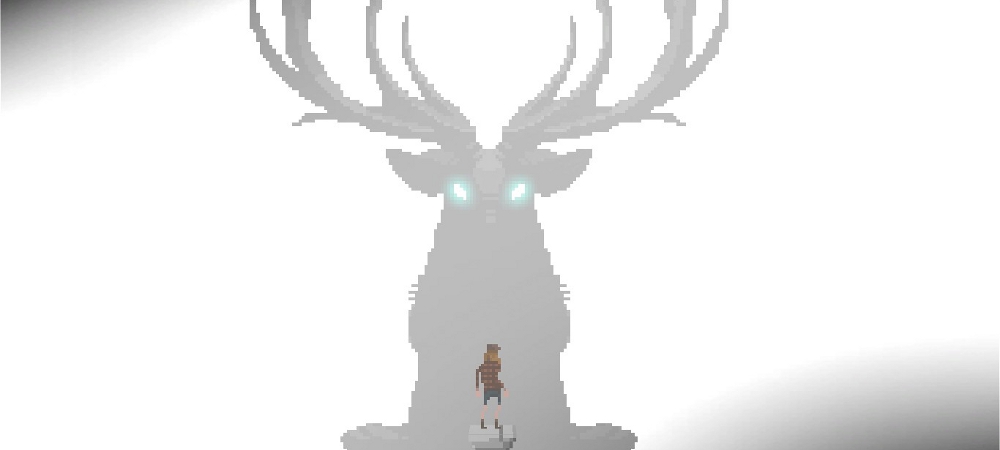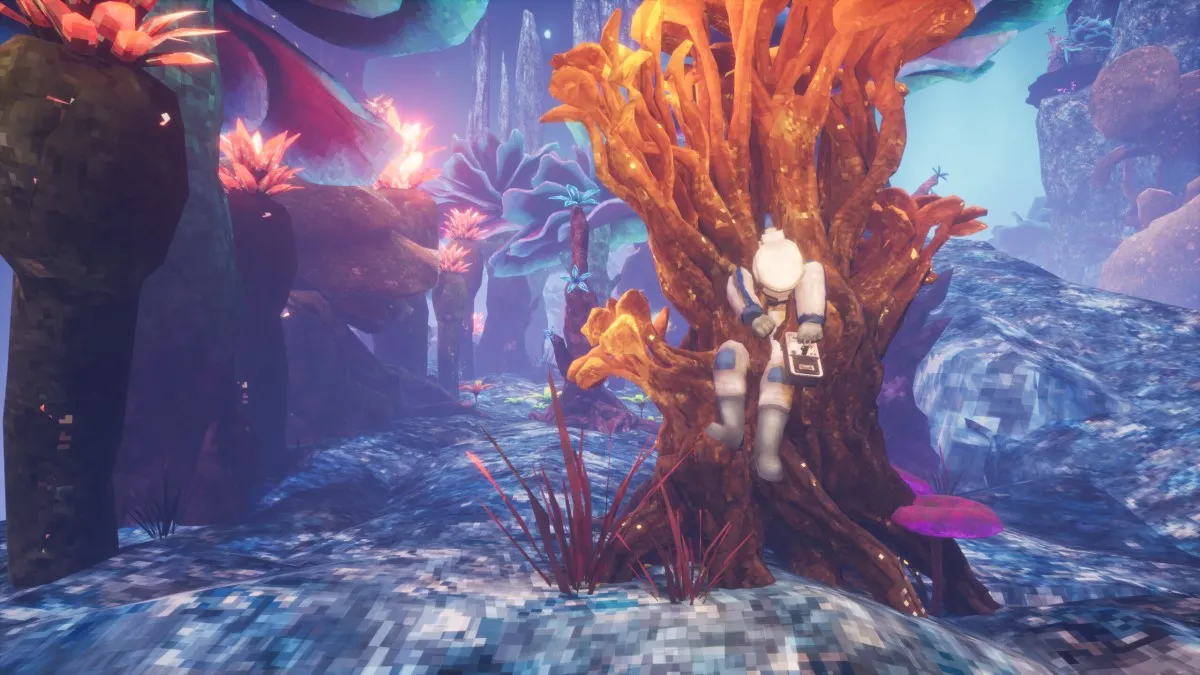Flawed fawn
In a lot of ways, The Deer God is a love letter to nature. The idea was born from the developers’ childhood memories of playing in the woods and seeing wild deer, and that admiration of the outdoors is quite apparent. The forests, fields, and other natural locations are simply gorgeous, and playing as a deer is as soothing as you might expect.
However, these tranquil moments eventually give way to some rather unfortunate gameplay decisions. I got a good sense of what the developers were going for, and in some respects they succeeded. But at times, it felt like they had too many ideas, or were trying to please too many people, resulting in a few areas of gameplay that fall flat or don’t seem to fit in very well. It’s still a very charming adventure, but it’s hard to look past its flaws.

The Deer God (PC)
Developer: Crescent Moon Games and Cinopt Studios
Publisher: Crescent Moon Games
Released: February 27, 2015
MSRP: $14.99
The Deer God places the player in the hooves of a young fawn, reincarnated from a hunter who died in an accident while shooting a majestic stag. To pay for your sins against nature, you must live as the deer you once hunted, roaming the lands and accumulating good karma in the hopes of pleasing the Deer God and returning to your human body.
Without a doubt, the best thing about this game is its gorgeous graphics, complemented by a peaceful, relaxing soundtrack. It’s essentially a 2D side-scroller set in a pixelated 3D world, with parallax scrolling to help the 3D pixel environments pop. There are lots of other effects that help make the world come to life, like beautiful lighting, weather conditions, background wildlife, and more. It’s quite stunning at times, but that alone wouldn’t be enough to give The Deer God a solid recommendation.
With mechanics influenced by endless runners and roguelikes, gameplay revolves around survival elements and environments that are procedurally generated as you run. In some respects, this works quite well. It’s fun at first to run around as a deer and explore the various landscapes, while foraging for food and dealing with enemies in your quest for survival. However, it felt as though the longer I played, the more these fundamental mechanics started to lose steam. The levels began to suffer from extreme repetition, as I found myself scaling the exact same walls, jumping over the exact same pits, and running into the exact same puzzles much too frequently. In some cases, such as while trying to complete quests, these mechanics even seemed detrimental to the gameplay itself.
As a deer, you can run, jump, and tackle enemies. More abilities can become unlocked later on. Some of these are gained through quest progression, while others are found randomly and require puzzle-solving to earn. The randomly found abilities include some pretty awesome techniques, like shooting fireballs from your antlers, growing plants to use as platforms, summoning bolts of lightning, and more. This is where the real fun comes from, but it’s a shame that these moves are sometimes very difficult to find, given the randomness of their locations.
The longer the deer lives, it will grow older, faster, and stronger, eventually maturing into a full-grown stag. But be careful not to die, because you might be reborn as a weak fawn again. When a new game is started, there are two difficulty settings to choose from: Normal and Hardcore. Normal mode will auto-save whenever a landmark is reached or a quest is discovered. These places act as checkpoints where new fawns will respawn after a deer dies. Hardcore mode is essentially perma-death, so if your lives run out, a whole new file must be started. Honestly, though, lives are so abundant that the difficulty setting really doesn’t make much of a difference. Not only are there extra lives that can be found throughout the environment, but you can also mate with other deer to create offspring that will carry on your legacy. Even playing in Hardcore mode, I always ended up with so many lives and offspring that I never felt pressured to be careful around spikes or enemies.
The enemies can be quite ferocious, but you can always just flee and avoid combat to stay alive. Fighting usually involves headbutting enemies over and over until someone wins, but the special abilities like antler fireballs can take foes down quickly. Then there are the boss enemies; these were the most exciting moments in the game for me. Two of the bosses are quest-related, but a few others, like giant cobras, badgers, and toads, are found randomly. Bosses require totally different strategies from normal enemies; sometimes parts of the environment must be used to your advantage, while other bosses will shield themselves from attacks or spawn smaller enemies to distract you. I wish more of the regular enemies required unique tactics like this.

As enemies are defeated, the karma bar will fill up with good karma. Bad karma can also be acquired by killing innocent animals. With too much bad karma, you might be reincarnated as a weaker animal such as a rabbit, which is essentially useless in combat. Finding a special totem will return the deer to its original form. I still don’t really know whether there are benefits to good or bad karma. It looks like there are light and dark abilities which can be unlocked depending on your karma, but even as a saintly stag, I was still able to unlock all of the evil abilities. This may have been a bug, but I’m not entirely sure.
Aside from the deer’s abilities, there are also items that can be found in bushes, barrels, and other hiding places. Items range from stat-enhancers, making you faster, stronger, or able to jump higher; friendly animals to be summoned, like bees, tortoises, and falcons that can fight for you; and other items with varying effects, like food to replenish health. Using items and abilities can be a little strange, though. They’re manually assigned to specific keys, but pressing each key essentially reassigns that item or ability to the shift key. So if fireballs are assigned to the first slot, you’ll hit the 1 key, then hit the shift key to shoot fireballs. This isn’t the greatest method; even when I thought I’d become accustomed to it, I’d still screw up often and use an unintended item or ability.
The Deer God may seem like an endless runner at first, and it can certainly become one if you want it to last forever, but there is a main quest line to be completed if you wish to achieve an ending. Unfortunately, the quests are by far the weakest aspect of the game. They range from fetch quests, to boss battles, to short, easily-solved puzzles. Many of them can be completed a mere couple of steps away from the starting point, but others require you to find the correct procedurally generated area, which can be a huge pain. Sometimes, this means looping through the same environments over and over again until you finally find the necessary location. It can be very annoying, but I suppose this was meant to be played as an endless runner anyway, so randomly discovering quest objectives might have been the point. Either way, aside from the boss battles, the quests are all so simple that they’re not very fun or satisfying. They’re essentially just menial tasks that must be completed in order to see the credits.

There’s also a multiplayer mode, which allows two friends to join a game together. The two players inhabit the same world, and can move around independently or work together to solve puzzles and discover new areas. The goal in multiplayer is simply to live as long as possible and find as many abilities and things as you can. There are no quests. If one player dies, they can come back to life if the other player mates with another deer to create a fawn. But if both players die, then it’s game over. I had quite a bit of fun messing around in multiplayer, although there was some weird lag at times.
As of this review, there were still quite a few bugs that I discovered during my time with the game. These were mostly visual bugs, like the train clipping through mountains and the health bar not appearing properly at times. Nothing game-breaking, but still distracting nonetheless. Hopefully they’ll get these sorted out in the next update.
The Deer God is a nice enough game to pick up and mess around with for an hour or so at a time, but the magic begins to wear off after a while. The layouts of the environments become monotonous too quickly, and the boring and occasionally tedious quests were an unfortunate addition. I feel as though it might have been more engaging as a true endless runner, testing how long you could survive as a deer and how far you could travel, kind of like what they did with the multiplayer mode. Of course, the abundance of extra lives currently makes it so that you really have to try to lose, so an endless run is not a very difficult endeavor at the moment.
I really do feel that there are some great ideas and potential here, though. I enjoyed running around the beautifully serene landscapes as a majestic deer, so if that’s all you really expect from The Deer God, then you’ll likely get some enjoyment out of it. Anyone looking for something more, however, might be left disappointed.
[This review is based on a retail build of the game provided by the publisher.]





Published: Feb 27, 2015 09:00 am